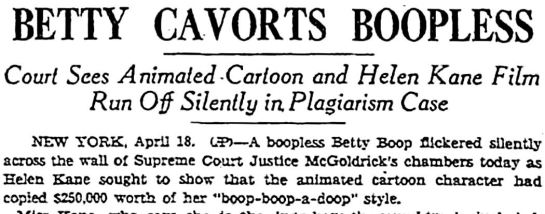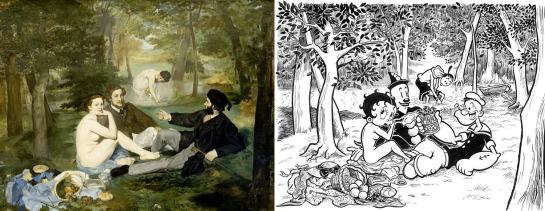Cultural Fads
.

by Richard Nilsen
.
One of the first court cases I’ve found that involves cultural appropriation occurred in 1934 and involves Betty Boop. Of course, cultural appropriation has been going on since before anyone thought of the term, but the Betty Boop case tells us something important about the issue.
.
Popular singer Helen Kane had a baby voice and scatted as she sang. In 1930, the Fleischer Brothers animation studio introduced Betty Boop and admittedly used a parody of Kane’s voice for Betty. Kane sued for $250,000 (equivalent to about $5 million today). The trial lasted two weeks and filled the newspapers with juicy stories.
.

.
“Sweet Betty” was described in the court case as “combin[ing] in appearance the childish with the sophisticated — a large round baby face with big eyes and a nose like a button, framed in a somewhat careful coiffure, with a very small body of which perhaps the leading characteristic is the most self-confident little bust imaginable.”
.
When witnesses described the nonsense syllables of scat singing, the court stenographer admitted she couldn’t spell such things.” And at one point, the judge, to preserve the dignity of the court had to admonish the participants to prevent any “audible booping.”
.

.
“Your honor,” said Kane’s lawyer to Justice Edward J. McGoldrick, “we contend this character [Betty Boop] has Miss Kane’s personality her mannerisms her plumpness, her curls, her eyes, and that she sings the songs Miss Kane made famous.” A style Kane called the “baby vamp.”
.

.
But it turns out that the Kane had copied the juvenile Black performer, Baby Esther Jones (aka L’il Esther) who used the same scat singing and baby voice before her.
.
The knowledge that Betty Boop imitated the white Kane who imitated the Black Baby Esther would likely nowadays raise the specter of “cultural appropriation” — a phrase that has now become something of an ethical fad. The outrage was there, but the term was not, when in the 1950s, Pat Boone sang tamed-down versions of Black R&B. The issue then was more about the money and who was ripping off whom.
.
But borrowing among artists is normal. It’s been going on forever and long before the current practice of sampling. After all, Baby Esther was known as a “Little Florence Mills,” imitating that singer. The actual Mills took over on Broadway from Gertrude Saunders in the 1921 hit, Shuffle Along. Each performer borrowing from the previous.
.
In the Fleischer trial, the famous pianist and composer Clarence Williams testified that he’d been using the scat technique since 1915. Very few things have virgin birth; most things are developments of other things. We could make the claim that scat began with Stephen Foster and Camptown Races and its “doo-dah, doo-dah” or to Christmas carols and their “fa-la-la,” or trace it back to the 16th century and Josquin de Prez’s frotolla El Grillo, where the singer imitates the sound of a cricket.
.

The whole issue of cultural appropriation is problematic, to say the least. I am not talking here about cases such as when an Anglo artist sells his work as Indian art, pretending to be Native American. That isn’t cultural appropriation, it is simply fraud. But when an artist finds something from another culture that piques his interest and creativity, well, that’s just normal. Everybody is always borrowing from everybody else. It is how culture moves forward.
.
.
Is spaghetti cultural appropriation because the tomato came from indigenous cultures in the New World?
.
Mexican, Japanese, and Filipino spaghetti
.

.
How about when spaghetti makes the journey back to the Americas and becomes Mexican chipotle spaghetti. Or further travels to Japan with added daikon, or to the Philippines, where they add hot dogs (pace Sheldon Cooper)?
.

.
In the Columbian Exchange, the New World gave the Old not only tomatoes, but corn (maiz), cacao, vanilla, potatoes and tobacco.
.

The Old gave back to the New grapes, onions, apples, wheat, to say nothing of swine, cattle, horses and honey bees.
.
So, today, there is nothing more typically Navajo than satellite dishes and pickup trucks. What we love as Navajo silver is something that was learned from Spanish silversmiths. The horses that the Plains Indians rode got to the New World from Europeans, and they got the idea of cavalry from the earlier invading Mongols. Shuffle, shuffle, shuffle.
.

.
It’s all a great mix, and to forbid such churn is to stall human progress. Culture is never static but always on the move. While remnants of the past persist in any culture, no culture remains “pure.” The call to preserve culture is a call to stuff and mount it like taxidermy. “Traditional” is always a museum-piece.
.
To function, culture must be both alive and unselfconscious. The moment you force a static definition on it, you kill it.
.
I’m not making a case here for blackface minstrelsy — such things are rightfully seen as appalling. But should that mean that Vanilla Ice should not rap? Or that Jessye Norman shouldn’t sing opera? That we should all be stuck in our particular silos and never learn from others?
.

George Harrison should never have learned the sitar? That Sergio Leone should have left the plot of A Fistful of Dollars to Akira Kurosawa?
.
That Cubism should be trashed because Picasso became fascinated by African masks?
.

.
This isn’t to say there aren’t egregious examples, but they mostly concern stereotyping — which is to say, ignorance, a failure to see what is actually going on in the other culture. Calling the Washington football team “Redskins” was always insulting. But finding something good and useful in another culture and adapting it is rather different, even if you take the original completely out of context.
.
Cross-fertilization is not only one of the pleasures of culture, but one of its essentials. Culture is a group enterprise, not an individual one, and it lives through free exchange.
.

.
I mentioned that the phrase “cultural appropriation” is recent, even if the problem is not. It is one of a series of intellectual fads that periodically take over our conversation. The biggest one now is “woke,” which is itself a culturally appropriated term, having originally been used in African-American lexicon to mean being aware of racial expectations in a multi-cultural context. Knowing what to look out for.
.
Now, it is used to demonize some idea that perhaps kindness is preferable to cruelty. It is a buzz word. Certain awarenesses surface in the culture, cause a hubbub, and then some new bauble attracts our attention and the previous buzzword gets a quiet place in the dictionary and our history books. New things draw us ever onward.
.
Before we had “cultural appropriation,” we had “cancel culture,” and before that, “power relationship,” and suddenly we were aware that some people had power over others, and perhaps bosses shouldn’t date subordinates. Whites had power; men had power; the rich had power. And so, what do we do with a Black woman manager dating her white assistant, when he is also her landlord? What is the power relationship there?
.

.
Even the idea of racism has changed. Years ago, anti-racism had a cloying paternalistic tone. Then came the ’60s even those who had been proud of their white racism were quick to say, “I’m not racist.” More recently, “racism” has been redefined so that whites can be racists while Blacks cannot because whites hold the power. And I’m not saying this isn’t true, but rather it is partial. Bigotry has no race and no power. It is a universal condition.
.
All of this simplifies what is forever muddled and complex, and those who want a simpler, more understandable world will try to enforce their simplicity on us all.
.
Power is only one dynamic. Culture is only one dynamic. Race is only one dynamic. Periodically, one small segment of life seems to grow immense and eclipse the others.
.
These things all come and go. In the late 19th century, the big thing was nationalism, which only wound up striking the match that ignited World War I. Then, there was temperance and the 18th Amendment. Come and gone. In the 1920s, we were all scared of anarchists and their bombs. They seemed to be everywhere — only then they disappeared from the newspapers for some reason.
.

In the ’30s, there was the growth of the KKK, and a rise in preachers haranguing about public morality, and the Hayes Code that followed.
.
We know about the Red Scare and the McCarthyism of the 1950s. The ’60s was all in a bunch about colonialism, as various nations found their way out into independence.
.
All these things seemed so vitally important, and knocked other things off the front pages. Then they evaporate, at least as public concern. The problems remain, but some new cause seems more immediately important.
.
I am not suggesting we should not be concerned with any of these things: They all play a part. But the world is multifarious and interests are always in conflict. If we currently tend to think of Europeans as the boogyman that infects the rest of the world, we should remember that American Indians fought and subjected neighboring tribes; China spread its hegemony over much of Asia; Africans enslaved Africans before the first Europeans ever set foot on the sub-Saharan continent. The record of humans interacting with other humans is not encouraging.
.
Richard Nilsen inspired many ideas and memories at the salons he presented through the years when he was an arts critic and movie, travel, and features writer at The Arizona Republic. A few years ago, Richard moved to North Carolina. We want to continue our connection with Richard and have asked him to be a regular contributor to the Spirit of the Senses Journal. We asked Richard to write short essays that were inspired by the salons.
.
